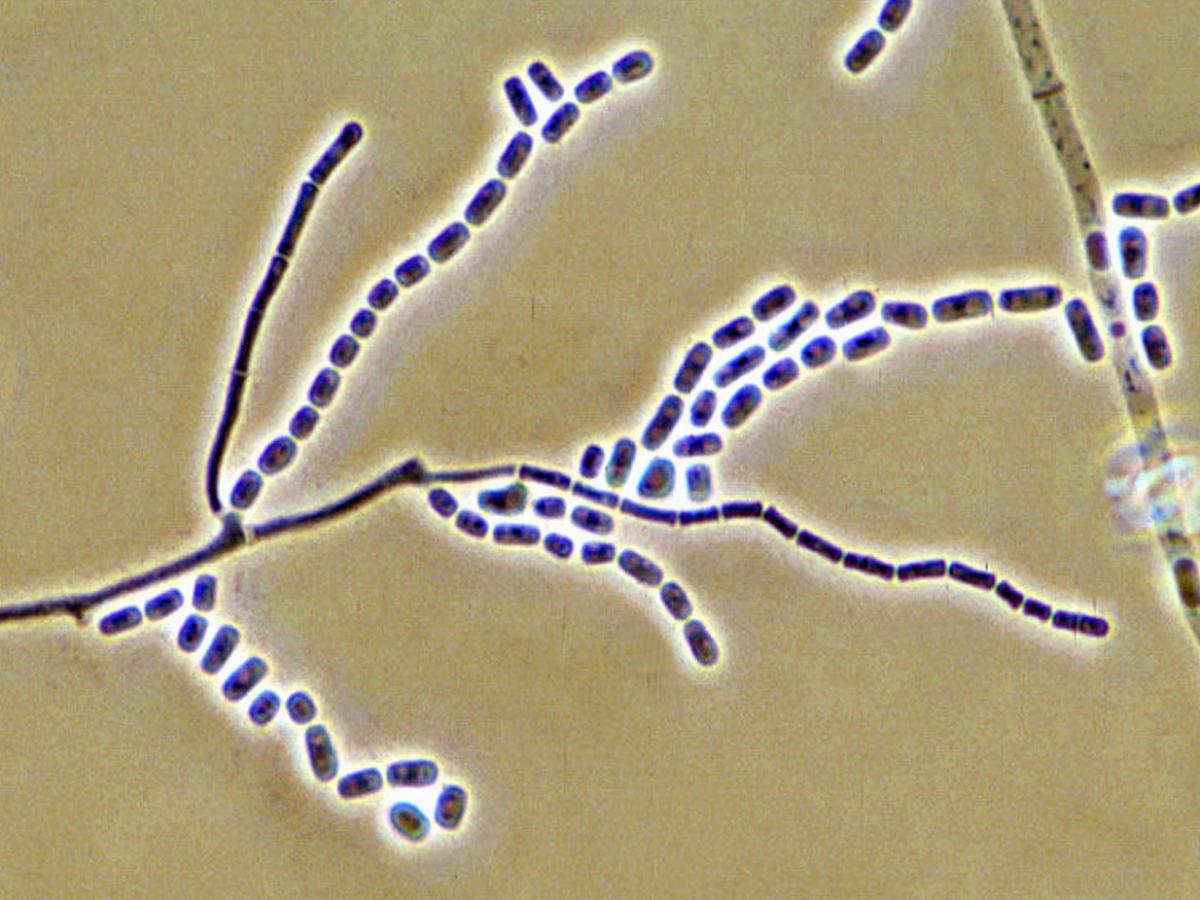Geotrichum candidum
Synonymy:
Dipodascus geotrichum, Galactomyces candidus

Geotrichum candidum arthroconidium formation.
The genus Geotrichum and related species have undergone extensive taxonomic revision (de Hoog and Smith 2004, 2011a, 2011b, 2011c). The three species of prime interest to medical mycology are as Geotrichum candidum, Magnusiomyces capitatus (previously known as Geotrichum capitatum), and Magnusiomyces clavatus (previously known as Saprochaete clavata or Geotrichum clavatum) (Kaplan et al., 2018, 2021).
Geotrichum candidum is an extremely common fungus with a worldwide distribution. It is commonly isolated from soil, air, water, milk, silage, plant tissues, and the digestive tract in humans and other mammals (Pottier et al. 2008). Pulmonary involvement is the most frequently reported form of the disease in humans and animals, but bronchial, oral, vaginal, cutaneous and alimentary infections have also been noted (Arendrup et al. 2014).
RG-1 organism.

Geotrichum candidum arthroconidium formation. Hyphal elements are progressively compartmentalised by fragmentation of septa. Conidial secession is by the centripetal separation (schizolysis) of a so called double septum and concomitant rupture of the original outer hyphal wall layer.
Morphological description:
Colonies are fast growing, flat, white to cream, dry and finely suede-like with no reverse pigment. Hyphae are hyaline, septate, branched and break up into chains of hyaline, smooth, one-celled, subglobose to cylindrical arthroconidia. Arthroconidia are 6-12 x 3-6 µm in size and are released by the separation of a double septum.
Note:
True blastoconidia production is not found in this genus. This characteristic distinguishes Geotrichum candidum from Trichosporon, which usually does produce blastoconidia.
Molecular identification:
ITS sequencing recommended for accurate species identification (de Hoog and Smith 2004).
| Germ Tube | - | L-Sorbose | v | L-Arabinose | - | D-Glucitol | + |
| Fermentation | Sucrose | - | D-Arabinose | - | 𝝰-M-D-glucoside | - | |
| Glucose | v | Maltose | - | D-Ribose | - | D-Gluconate | - |
| Galactose | v | Cellobiose | - | L-Rhamnose | - | DL-Lactate | + |
| Sucrose | - | Trehalose | - | D-Glucosamine | - | myo-Inositol | - |
| Maltose | - | Lactose | - | NAD-glucosamine | nd | 2-K-D-Gluconate | - |
| Lactose | - | Melibiose | - | Glycerol | + | D-Glucuronate | nd |
| Trehalose | - | Raffinose | - | Erythritol | - | Nitrate | - |
| Assimilation | Melezitose | - | Ribitol | v | Urease | - | |
| Glucose | + | Soluble Starch | - | Galactitol | - | 0.1% Cycloheximide | nd |
| Galactose | + | D-Xylose | + | D-Mannitol | + | Growth at 40C | v |
References:
Gueho (1979), Domsch et al. (1980), McGinnis (1980), Barnett et al. (1983), Buchta and Otcenasek (1988), Samson et al. (1995), de Hoog et al. (1986, 2015), de Hoog and Smith (2004, 2011a, 2011b, 2011c).
| Antifungal susceptibility: Geotrichum candidum limited data (Australian national data); MIC µg/mL. | |||||||||||||
|---|---|---|---|---|---|---|---|---|---|---|---|---|---|
| No | ≤0.03 | 0.06 | 0.125 | 0.25 | 0.5 | 1 | 2 | 4 | 8 | 16 | 32 | ≥64 | |
| AmB | 9 | 1 | 3 | 3 | 2 | ||||||||
| FLU | 9 | 3 | 4 | 2 | |||||||||
| ISAV | 4 | 2 | 1 | 1 | |||||||||
| VORI | 9 | 1 | 2 | 5 | 1 | ||||||||
| POSA | 8 | 2 | 6 | ||||||||||
| ITRA | 9 | 5 | 4 | ||||||||||
| ANID | 7 | 2 | 1 | 4 | |||||||||
| MICA | 7 | 2 | 1 | 4 | |||||||||
| 5FC | 9 | 8 | 1 | ||||||||||
